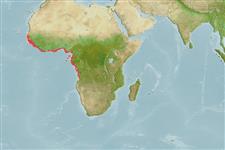Malacostraca |
Decapoda |
Palaemonidae
Environment: milieu / climate zone / تغييرات عمق / distribution range
بوم شناسي
موجوداتی که در محدوده وسیعی از آبهای آزاد از نزدیک بستر و یا روی کف بستر، در قسمت های میان آبی تا سطح آب و در برخی گونه ها با قابلیت پرواز، زندگی و تغذیه می کنند.; لب شور; تغييرات عمق 3 - 740 m (مرجع 105050). Tropical; 16°N - 17°S, 18°W - 14°E
Eastern Atlantic: along West African coast, from Senegal to Angola.
Length at first maturity / Size / Weight / سن
بلوغ: Lm ? range ? - ? cm Max length : 7.5 cm TL جنس نر / بدون خواص جنسي; (مرجع 434)
Pelagic (Ref. 105112). Exploited in the continental shelf (Ref. 121688). Inshore, prefers high salinity river mouths (Ref. 121669). Also found on sandy and muddy bottoms in estuarine and coastal marine waters to depths of about 50 m (Ref. 434). Mainly feeds on mysids and copepods. Preyed upon by fish and decapods (Ref. 105112).
Life cycle and mating behavior
بلوغ | تولید مثل | تخم ریزی | Eggs | Fecundity | Larvae
Members of the order Decapoda are mostly gonochoric. Mating behavior: Precopulatory courtship ritual is common (through olfactory and tactile cues); usually indirect sperm transfer.
مآخذ اصلی
مراجع | هماهنگ كننده | همكاران
Fischer, W., G. Bianchi and W.B. Scott (eds.) 1981 Shrimps and prawns. 6: pag.var. In FAO species identification sheets for fishery purposes. Eastern Central Atlantic (Fishing Area 34, 47; in part). Canada Funds-in-Trust. Ottawa, Department of Fisheries and Oceans Canada, by arrangement with the Food and Agriculture organization of the United Nations. 1-7: pag.var. (مرجع 434)
وضعيت در فهرست قرمز IUCN
(مرجع 130435: Version 2025-1)
وضعيت از نظر سايتس (مرجع 108899)
Not Evaluated
Not Evaluated
خطر برای انسان ها
استفاده انسانی
ماهي گيري – شيلات: تجاري
FAO - ماهي گيري – شيلات: landings | FishSource |
ابزارها
اطلاعات بيشتر
Life cycleتولید مثلبلوغFecundityتخم ریزیEggsنمو تخمLarvae PhysiologyOxygen consumption
Human RelatedStamps, coins, misc.
منابع اينترنتي
Estimates based on models
Preferred temperature
(Ref.
115969): 11 - 16.4, mean 14.2 (based on 40 cells).
Fishing Vulnerability
Low vulnerability (10 of 100).
